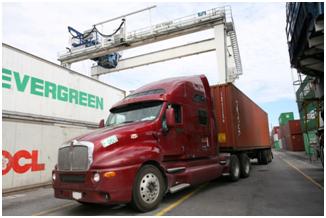What’s the first thing that springs to your mind when you hear the phrase, “British Columbia is Canada’s pacific gateway“? Do you see British Columbia as a hub of transportation activity,
that springs to your mind when you hear the phrase, “British Columbia is Canada’s pacific gateway“? Do you see British Columbia as a hub of transportation activity,
with a network of boats, trains, planes and automobiles all working together seamlessly to transport people and goods across BC, Canada, and the US? We do. And since 2005 we’ve been working with other governments, ports, airports, rail lines, commercial haulers and other public and private stakeholders to make that vision a reality. That vision is the Pacific Gateway Strategy.
A major focus of that strategy is taking advantage of Asia’s growing demand for our products, like, coal, natural gas, potash, grain, even seafood. It’s a massive undertaking, but it’s paying off. Traffic through Port Metro Vancouver and the Port of Prince Rupert has increased impressively. Just as an example, let’s take a look at how exports have gone up since 2010:
- Total coal tonnage is up 16 per cent at the Port of Prince Rupert;
- Potash is up 30 per cent to a new record of 7.2 million metric tonnes;
- Seafood exports to China exceeded $100 million in 2011;
- Grain is up 17 per cent.
One of the reasons for this success has to do with geography. Our ports are actually closer to these Asian markets than any others on the west coast. A ship arriving from Asia can be here up to three days faster than if it was headed to Los Angeles, which can save shippers a lot of money.
So what does all this mean for us? Plenty! As markets expand and our economy grows, new jobs are created to meet the demand. But that’s not the only benefit you’ll see. Investing in our roads and bridges means you’ll be able to get to home and work safer and easier than before. In the Lower Mainland, projects like the South Fraser Perimeter Road and the Port Mann/Highway 1 Improvement Project will see more transit and cycling options for commuters and a better separation of trains and commercial haulers from regular traffic. And programs like the Cariboo Connector, the Kicking Horse Canyon and the Okanagan Valley Corridor will bring similar benefits to people across the province.
Here’s a mini-movie about how the Pacific Gateway will expand our transportation network, make it easier to get our goods to market and help with B.C.’s economy:
The Pacific Gateway is a big part of the economic growth of our province. Connect with us on Twitter and/or Facebook and let us know if you have any questions we can answer.
As a fundamental improvement to the Gateway project – twinning the Trans Canada highway between Kamloops and the Alberta boarder – the trucking industry would greatly contribute to this endeavor and also make highway travel safer for BC and Canadian citizens.
Hi Erv,
Thanks for connecting with us here about the Trans-Canada Highway between Kamloops and the Alberta border. While twinning this important route may not be possible along the entire route, we are currently working toward four-laning the highway wherever possible. Here’s our website link, where you can learn more about it: http://engage.gov.bc.ca/bchwy1/
As an editor at BIV Media, I am looking for a colourful graphic/map that shows the Pacific Gateway pieces and how they work together.
Got something like that in a high-res version?
Frank O’Brien
editor
BIV Media Group
managing editor. Invest in BC magazine
604-669-8500 ext 104
Hi Frank,
Let us look into that for you. In the meantime, we found this link, and contact information for the Pacific Gateway Branch.
http://www.pacificgateway.gov.bc.ca/documents/120402_Gateway_Strategy.pdf
You can also contact the Pacific Gateway Branch
Phone:
250-356-2104
Email:
PacificGatewayInfo@gov.bc.ca
Hi again Frank,
We connected with the folks in the Pacific Gateway Branch and although they don’t have a graphic like the one you asked for they thought it would be a great one to have. When would you need it by?